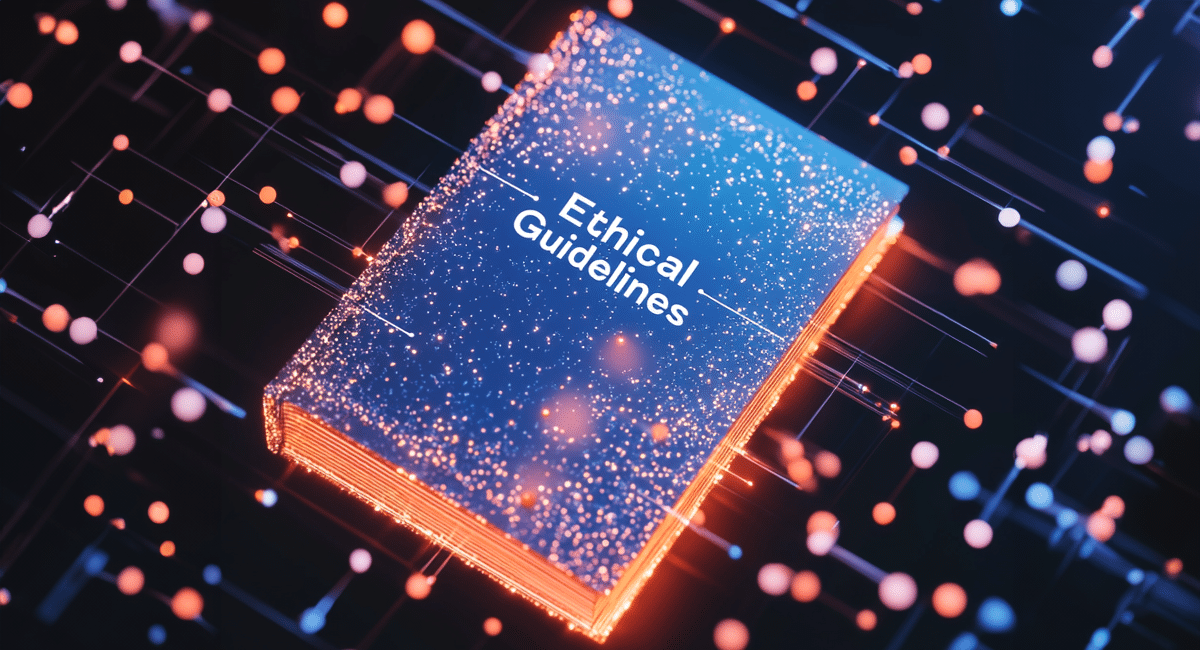Generative AI has presented businesses with unprecedented access to data and the tools to mine that data. It’s tempting to see all data as beneficial, but the older-than-AI rule, Garbage In, Garbage Out, still applies. To truly understand the effectiveness and safety of GenAI in your company, one must carefully examine the algorithms powering it for potential bias, to ensure data sources are legitimate, and to verify that you have permission to use the data.
An AI ethics board is an overseer, an entity guiding AI research, development, and deployment in an organization. It’s what ensures that your AI systems are designed and used responsibly, keeping the balance between innovation and ethical considerations. By interpreting ethical principles and applying them to specific projects, the board corroborates that your company’s AI activities are transparent, accountable, and aligned with broader societal values.
Defining the Responsibilities of the AI Ethics Board
Why do you need an AI ethics committee or board? Defining the responsibilities of such an entity should be the first step on the path to establishing an effective governance structure that will guide your company through the ongoing management of ethical AI. By defining the board’s responsibilities in its charter, or bylaws, you can ensure clarity and accountability from the outset.
Providing Strategic Advice
The primary purpose of the AI ethics board is to advise the company’s leadership on AI-related research priorities, commercialization strategies, strategic partnerships, and fundraising activities. The board is essentially a gauge of balance pointing at how well profit motives are aligned with ethical standards, preventing any negative impact that could be caused by aggressive market tactics.
The board assesses strategic partnerships to ensure they align with the company’s ethical framework. They also advise on fundraising, mergers, and acquisitions, emphasizing long-term ethical impacts over short-term gains.
Overseeing Development and Deployment
In addition to advisory roles, the board should oversee the development and deployment of AI systems. This includes modeling rollout plans and creating release strategies that prioritize safety. For example, before deploying a powerful AI model, the board might recommend a staged release, where a smaller version of the model is initially deployed to monitor its real-world impacts.
By establishing norms for the responsible publication of research, the board can mitigate risks associated with disseminating potentially harmful information.
Interpreting and Operationalizing Ethics Principles
Many AI companies have broad ethical guidelines, but these need to be practically applied to specific situations. The board can interpret these principles in the context of individual projects, ensuring that the company’s activities align with its stated ethical commitments. This might involve reviewing and updating the principles periodically to address emerging ethical challenges and ensuring that they remain relevant and effective.
Mitigating Extreme Risks
Mitigating risks, particularly those associated with advanced AI systems, is a key responsibility of the board. Its members should focus on preventing these systems from being misused or causing unintended harm. This includes developing policies to handle info hazards as sensitive information could be harmful if misused.
Selecting and Overseeing Board Members
Who sits on the board matters immensely. The AI ethics committee should choose initial members aiming for a blend of technical expertise, ethical insight, and legal knowledge. Ongoing appointments must be transparent, with clear criteria to ensure the board evolves while maintaining its high standards. Regular evaluations of members help keep the board dynamic and responsive to new ethical challenges in AI.
Determining the Legal Structure
The structure of an AI Ethics Board will influence the board’s effectiveness, independence, and how it integrates within the company. Broadly speaking, there are two main types of structures: internal boards and external boards.
Internal AI Ethics Boards
Internal AI ethics boards operate within the company. Members are employees, and the company has direct control over the board’s activities, structure, and membership. The main advantage lies in the proximity. An internal board can easily access company information; it has an in-depth understanding of the company’s culture and internal processes. This familiarity can lead to more informed and context-sensitive decisions.
However, since senior management can directly influence or even dismiss board members, an internal board might struggle to maintain independence. This proximity can make it challenging for the board to adopt an adversarial role when needed or to openly discuss risks that conflict with other company objectives e.g. profit maximization. Additionally, internal boards typically lack legal power to enforce their decisions, relying instead on good relationships with management and the board of directors.
External AI Ethics Boards
There are various ways one can structure an external AI ethics board. It could be a nonprofit organization, a public-benefit corporation, or even a more complex setup like Meta’s Oversight Board, which consists of a purpose trust and a limited liability company (LLC). The LLC contracts individuals who then provide services to the company. However, regardless of the solution, external boards are separate legal entities that contract with the company.
This separation offers greater independence and credibility as an external board is less influenced by internal company politics and incentives, which can enhance its objectivity and authority. Moreover, external boards can legally bind the company through contractual agreements, making their decisions more enforceable.
With the distance, comes a different set of challenges, though. An external board might take longer to obtain detailed information about the company and integrate into its operations. Also, few companies are willing to make the strong commitment required to set up such an independent entity.
AI Ethics Board Substructures
Both internal and external AI ethics boards can benefit from having substructures to handle specific responsibilities. These can include:
- Committees
- Permanent Committees: These are established to manage ongoing and recurrent issues that demand consistent oversight and deep expertise. They become the base for long-term initiatives and ensure that critical areas are continuously monitored.
- Temporary Committees: Formed to tackle specific projects or pressing issues, these committees bring together experts to focus on a singular task. These committees are disbanded once their task is completed.
- Liaisons: Liaisons act as the connective tissue between the ethics board and various organizational factions, such as R&D teams or the executive board. By embedding themselves within these units, liaisons ensure that the ethical perspectives and guidelines established by the ethics board are considered in decision-making processes across the company.
Selecting Board Members
Only the right people can make an AI ethics board truly effective. Here’s how to go about appointing the initial members, filling subsequent positions, and identifying the essential qualities of board members.
Initial Appointment
At this stage, a formation committee— a composition of senior executives, external advisors, and key stakeholders—is responsible for identifying and recruiting the first members of the AI board of ethics. They begin by establishing rigorous selection criteria to ensure candidates possess the necessary merger of technical expertise, ethical insight, legal acumen, and professional experience. The aim is to identify individuals with deep knowledge of AI and its implications, a solid ethical foundation, and preferably, a history of professional integrity.
Once a pool of candidates is identified, the evaluation process begins. This includes initial screenings of resumes and preliminary interviews to assess basic qualifications. Shortlisted candidates then undergo more thorough interviews focused on their expertise, ethical perspectives, and understanding of AI-related issues. Background checks are conducted to verify their professional history and ensure there are no conflicts of interest. The committee also seeks endorsements from respected figures in the industry and conducts reference checks to ensure the candidates’ credibility and suitability.
The final selection is a collaborative decision within the formation committee.
Subsequent Appointments
Once the initial board is set up, appointing new members should follow a transparent, systematic process to uphold integrity. Nominations—that are to undergo a rigorous evaluation process—may come from current board members, company leadership, or external stakeholders.
The evaluation should be thorough, echoing the diligence of the initial appointment. This involves detailed vetting of candidates’ qualifications, technical expertise, ethical insight, and legal knowledge.
Characteristics of Members
Selecting the right individuals for an AI ethics board involves identifying candidates with specific characteristics that ensure the board’s effectiveness and credibility:
- Expertise: Multidisciplinary expertise ensures that the board members are capable of understanding and addressing varied issues that arise with AI development and deployment
- Technical expertise includes knowledge of AI technologies, data science, machine learning, and cybersecurity.
- Ethical expertise connotes understanding ethical theories, technology ethics, and the social implications.
- Legal expertise bounds familiarity with regulations, intellectual property law, data privacy laws, and compliance issues
- Diversity: A diverse board—including gender, race, ethnicity, and geographical representation—can better understand and address the needs and concerns of different communities affected by AI technologies. A more diverse board gives the rightful impression of being more committed to inclusivity and representation.
- Seniority: Senior figures with extensive experience bring authority, leadership, and a deep understanding of industry practices and ethical considerations that come with their experience. They can mentor newer members and provide strategic direction. Less seasoned experts and younger professionals bring in a fresh perspective and are more likely to boast an up-to-date understanding of the latest advancements and trends in AI.
- Public Perception: Members must have impeccable reputations, free from conflicts of interest or ethical breaches, as they should be seen as impartial, dedicated to upholding high ethical standards, and committed to the responsible development and deployment of AI.
Establishing Decision-Making Processes
Clear and effective decision-making processes translate to systematically made, transparent, and inclusive resolutions of the AI board of ethics.
Voting Procedures
The foundation of a board’s decision-making is its voting procedure. Different types of decisions require different majorities. Routine decisions might only need a simple majority, whereas critical or contentious issues may demand a two-thirds majority or even unanimous consent to reflect a broader consensus and lend greater legitimacy.
Clearly defining a quorum prevents a small, potentially unrepresentative subset of the board from making important decisions. Setting it at a level that balances inclusiveness and efficiency ensures that decisions are made with adequate representation without stalling the board’s work.
Allowing abstentions and proxy voting accommodates members who might have conflicts of interest or who cannot attend a meeting. This flexibility helps maintain high ethical standards and ensures that the decision-making process is inclusive and comprehensive.

Meeting Frequency
The cadence of meetings directly influences the board’s oversight capabilities, decision-making speed, and overall efficiency. Regular meetings provide a structured framework for the board to review ongoing projects, assess new initiatives, and ensure continuous oversight. These meetings can be scheduled monthly, quarterly, or biannually, depending on the board’s workload and the pace of the company’s AI activities.
Ad-Hoc Meetings
Ad-hoc meetings are called for whenever an urgent matter that needs addressing arises between regular appointments. The trigger events for such meetings include emerging ethical dilemmas, unforeseen risks, or significant changes in AI project scopes. With ad-hoc meetings, the board remains proactive and responsive to immediate concerns.
For ad-hoc meetings to be effective, there must be a streamlined process for notifying members and scheduling these sessions quickly. This often involves digital tools and clear protocols to minimize delays and ensure full participation.
Documentation
Proper documentation practices create a clear record of decisions and discussions, which is crucial for maintaining internal coherence and external trust.
Detailed Minutes
Every meeting’s output should include detailed minutes that accurately capture the discussions, decisions, and action items. This includes listing all attendees, documenting the main points of debate, recording the specific decisions made, and noting any assigned tasks. It will be an official record and a historical account of the board’s deliberations.
Decision Rationale
For each decision, especially significant or potentially controversial ones, it is important to document the rationale behind it. This should involve the ethical principles, data, and arguments considered. This level of detail that helps to understand the board’s decision-making process will be essential for defending decisions should they ever come to be questioned.
Dissenting Opinions
When board members disagree with a decision, their arguments should be recorded. This practice not only shows transparency but also respects the diverse perspectives within the board. Documenting dissenting opinions ensures that even the minority views are acknowledged and considered in the board’s records.
Action Items and Follow-Ups
Clearly documenting any action items that arise from meetings, along with who is responsible for each task and the deadlines for completion, is indispensable. In addition, follow-up actions should be tracked and recorded to ensure accountability and progress. This practice helps in maintaining a clear and organized approach to implementing the board’s decisions.
Structured Documentation System
Only organized records are the records that can be later found. A structured documentation system can include digital tools for recording minutes, secure databases for storing documents, and standardized formats for documenting decisions and action items. A well-organized system facilitates easy retrieval of information and ensures consistency in how records are kept.
Confidentiality and Security
Given the sensitive nature of discussions around AI ethics, ensuring that all documentation is kept confidential and secure is an obvious duty. Access to these records should be restricted to authorized personnel only. Consequently, sturdy cybersecurity measures should be in place in order to protect this data against unauthorized access or breaches.
Ensuring Adequate Resources
An AI ethics board can’t function effectively without sufficient resources. This includes not only funding but also access to necessary information and external expertise.
Funding
The board’s operations need a solid financial backbone. Primary funding typically comes from the company itself, which must be committed to supporting the board’s mandate. However, relying solely on company funding can compromise perceived independence. To counter this, boards can also seek funding from external sources:
- Philanthropic Contributions: Philanthropists, especially recently, have been eager to support initiatives that aim to mitigate the societal risks associated with AI, providing a financial buffer that allows the board to operate more freely.
- Academic and Non-Profit Grants: Applying for these grants requires a clear proposal and a track record of impactful work, but they can significantly enhance the board’s capabilities and resources.
Indirect Funding Mechanisms
Indirect funding mechanisms allow for true independence of the board—securing its financial needs while distancing it from the direct financial influence of the company:
- Independent Trusts: The company can allocate a portion of its profits or a fixed annual contribution to this trust, which then funds the board. This mechanism ensures that the board has a steady stream of income that is not directly tied to the company’s immediate financial interests.
- Endowments: By creating an endowment, where the principal amount remains intact and only the investment income is used, the board can secure a consistent funding source that can support the board’s operations indefinitely.
- Public Funding: Public funding is not always applicable and it does involve traveling through bureaucratic processes and demonstrating significant societal benefit, but it can add to the board’s financial independence.
Information Access
For an AI ethics board to function at its best, it needs unfiltered access to comprehensive information. This means setting up smart ways to gather necessary data, balancing what the company provides with independent sources, and ensuring all information remains confidential and intact.
Getting the right data starts with solid internal information channels. The board must have access to detailed reports on AI projects, minutes from relevant meetings, internal audit reports, and compliance documentation. The company should appoint a liaison or team to facilitate this flow of information. Clear data request protocols are essential, detailing how requests are made, the types of information needed, and expected response times. This systematic approach ensures nothing crucial slips through the cracks.
Balancing internal information with insights from independent sources is a way for an unbiased perspective:
- Third-Party Audits and Reports: Hiring outside firms to conduct audits and create reports offers an impartial view. These audits can examine everything from the technical integrity of AI systems to compliance with ethical guidelines and regulatory requirements.
- Research and Analysis from External Experts: Partnering with academic researchers and industry consultants brings in independent analysis and critiques of the company’s AI practices. These collaborations provide access to the latest studies and innovative approaches to ethical AI.
- Publicly Available Data: Using regulatory filings, industry reports, academic publications, and news articles helps the board compare the company’s practices with industry standards and identify best practices.
Cross-verifying company-provided information with independent data ensures a well-rounded perspective. This involves:
- Triangulation: Comparing internal data with findings from third-party audits, external expert reports, and public sources to spot discrepancies and confirm accuracy.
- Regular Updates and Reviews: Setting up a routine for periodic assessments of internal reports, consultations with external experts, and monitoring relevant public data ensures the board stays updated and can adjust its oversight practices as environments change.
Forming an AI Ethics Boards Require Careful Planning and Execution
Establishing an AI ethics board is a comprehensive process that requires careful planning and execution.
Begin by outlining the board’s responsibilities in a detailed charter. Ensure that the board is composed of members with a diverse mix of technical expertise, ethical insight, and legal knowledge. Whether you opt for an internal or external structure, ensure the board’s independence and credibility. Regular evaluations and transparent appointment processes are key to maintaining high standards.
The decision-making process should have a solid foundation, with clear voting procedures and a defined quorum to ensure inclusiveness and efficiency. Regular and ad-hoc meetings should be documented conscientiously, capturing detailed minutes, decision rationales, dissenting opinions, and follow-ups. This documentation is what builds internal coherence and external trust.
Adequate resources are not to be forgotten about; they are essential for the board’s effective functioning. Secure funding through various sources to ensure financial independence. Provide the board with comprehensive access to necessary information, balancing internal data with independent sources for an unbiased perspective.




